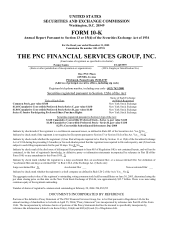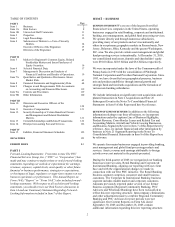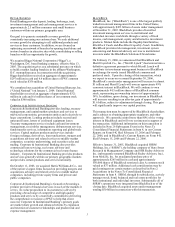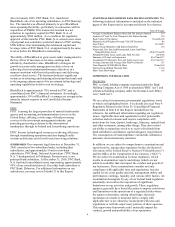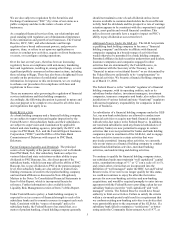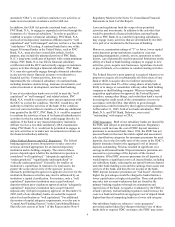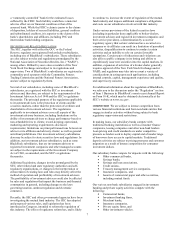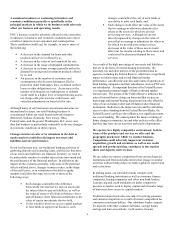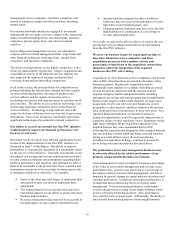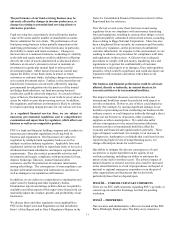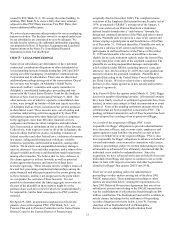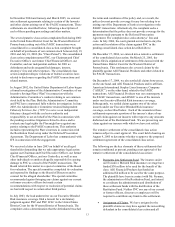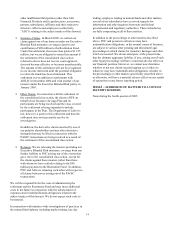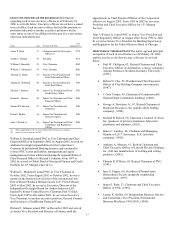PNC Bank 2005 Annual Report Download - page 5
Download and view the complete annual report
Please find page 5 of the 2005 PNC Bank annual report below. You can navigate through the pages in the report by either clicking on the pages listed below, or by using the keyword search tool below to find specific information within the annual report.
5
We are also subject to regulation by the Securities and
Exchange Commission (“SEC”) by virtue of our status as a
public company and due to the nature of some of our
businesses.
As a regulated financial services firm, our relationships and
good standing with regulators are of fundamental importance
to the continuation and growth of our businesses. The Federal
Reserve, OCC, SEC, and other domestic and foreign
regulators have broad enforcement powers, and powers to
approve, deny, or refuse to act upon our applications or
notices to conduct new activities, acquire or divest businesses
or assets, or reconfigure existing operations.
Over the last several years, there has been an increasing
regulatory focus on compliance with anti-money laundering
laws and regulations, resulting in, among other things, several
significant publicly announced enforcement actions, including
those relating to Riggs. There has also been a heightened focus
recently on the protection of confidential customer
information. In response to this environment, we are working
to enhance our procedures for compliance with laws and
regulations in these areas.
There are numerous rules governing the regulation of financial
services institutions and their holding companies.
Accordingly, the following discussion is general in nature and
does not purport to be complete or to describe all of the laws
and regulations that apply to us.
BANK REGULATION
As a bank holding company and a financial holding company,
we are subject to supervision and regular inspection by the
Federal Reserve. Our subsidiary banks and their subsidiaries
are subject to supervision and examination by applicable
federal and state banking agencies, principally the OCC with
respect to PNC Bank, N.A. and the Federal Deposit Insurance
Corporation (“FDIC”) and the Office of the State Bank
Commissioner of Delaware with respect to PNC Bank,
Delaware.
Parent Company Liquidity and Dividends. The principal
source of our liquidity at the parent company level is dividends
from PNC Bank, N.A. Our subsidiary banks are subject to
various federal and state restrictions on their ability to pay
dividends to PNC Bancorp, Inc., the direct parent of the
subsidiary banks, which in turn may affect the ability of PNC
Bancorp, Inc. to pay dividends to PNC at the parent company
level. Our subsidiary banks are also subject to federal laws
limiting extensions of credit to their parent holding company
and non-bank affiliates as discussed in Note 4 Regulatory
Matters in the Notes To Consolidated Financial Statements in
Item 8 of this Report, which is incorporated herein by
reference. Further information is also available in the
Liquidity Risk Management section of Item 7 of this Report.
Under Federal Reserve policy, a bank holding company is
expected to act as a source of financial strength to each of its
subsidiary banks and to commit resources to support each such
bank. Consistent with the “source of strength” policy for
subsidiary banks, the Federal Reserve has stated that, as a
matter of prudent banking, a bank holding company generally
should not maintain a rate of cash dividends unless its net
income available to common shareholders has been sufficient
to fully fund the dividends and the prospective rate of earnings
retention appears to be consistent with the corporation's capital
needs, asset quality and overall financial condition. This
policy does not currently have a negative impact on PNC’ s
ability to pay dividends at our current level.
Additional Powers Under the GLB Act. The GLB Act permits
a qualifying bank holding comp any to become a “financial
holding company” and thereby to affiliate with financial
companies engaging in a broader range of activities than
would otherwise be permitted for a bank holding company.
Permitted affiliates include securities underwriters and dealers,
insurance companies and companies engaged in other
activities that are determined by the Federal Reserve, in
consultation with the Secretary of the Treasury, to be
“financial in nature or incidental thereto” or are determined by
the Federal Reserve unilaterally to be “complementary” to
financial activities. We became a financial holding company
as of March 13, 2000.
The Federal Reserve is the “umbrella” regulator of a financial
holding company, with its operating entities, such as its
subsidiary broker-dealers, investment managers, investment
companies, insurance companies and banks, also subject to the
jurisdiction of various federal and state “functional” regulators
with normal regulatory responsibility for companies in their
lines of business.
As subsidiaries of a financial holding company under the GLB
Act, our non-bank subsidiaries are allowed to conduct new
financial activities or acquire non-bank financial companies
with after-the-fact notice to the Federal Reserve. In addition,
our non-bank subsidiaries (and any financial subsidiaries of
subsidiary banks) are now permitted to engage in certain
activities that were not permitted for banks and bank holding
companies prior to enactment of the GLB Act, and to engage
on less restrictive terms in certain activities that were
previously permitted. Among other activities, we currently
rely on our status as a financial holding company to conduct
mutual fund distribution activities, merchant banking
activities, and underwriting and dealing activities.
To continue to qualify for financial holding company status,
our subsidiary banks must maintain “well capitalized” capital
ratios, examination ratings of “1” or “2” (on a scale of 1 to 5),
and certain other criteria that are incorporated into the
definition of “well managed” under the BHC Act and Federal
Reserve rules. If we were to no longer qualify for this status,
we could not continue to enjoy the after-the-fact notice
process for new non-banking activities and non-banking
acquisitions, and would be required promptly to enter into an
agreement with the Federal Reserve providing a plan for our
subsidiary banks to meet the “well capitalized” and “well
managed” criteria. The Federal Reserve would have broad
authority to limit our activities. Failure to satisfy the criteria
within a six-month period could result in a requirement that
we conform existing non-banking activities to activities that
were permissible prior to the enactment of the GLB Act. If a
subsidiary bank failed to maintain a “satisfactory” or better
rating under the Community Reinvestment Act of 1977, as

